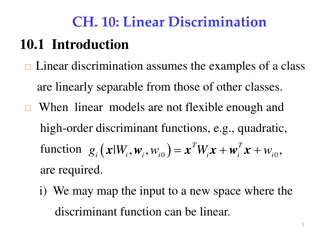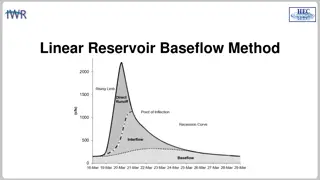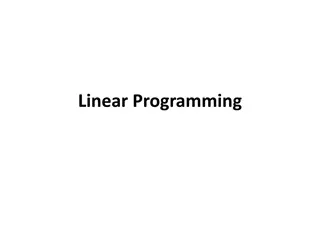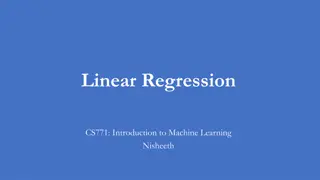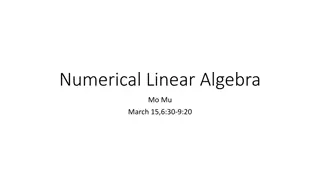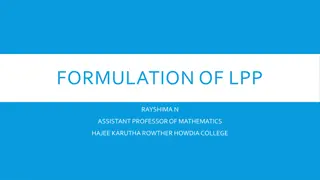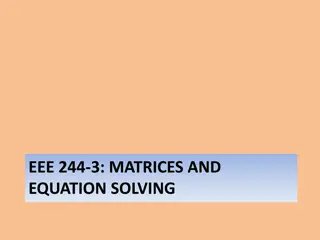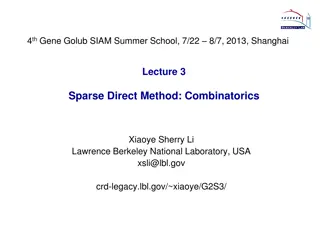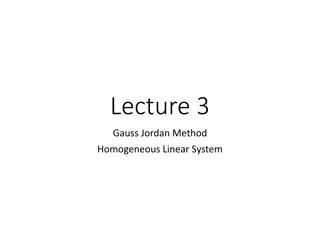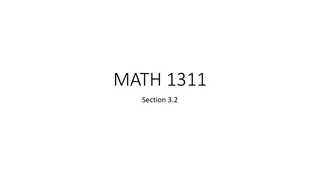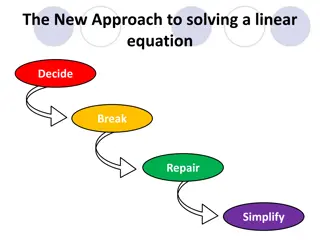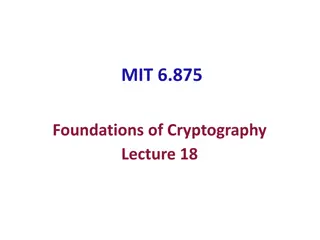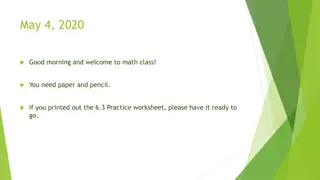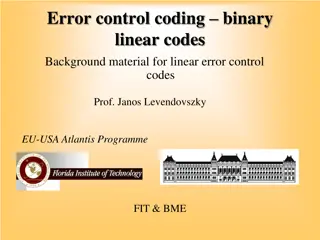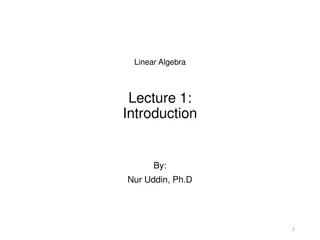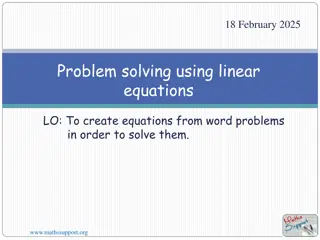
Solving Linear Equations: Strategies and Methods
Discover the essential strategies and methods for solving systems of linear equations efficiently. From equivalent systems to augmented matrices and elementary row operations, learn how to simplify and find solutions effectively. Explore techniques like interchanging rows, scaling, and row addition to transform complex equations into manageable forms. Master the art of reducing systems to reduced row echelon form for quick solutions.
Download Presentation

Please find below an Image/Link to download the presentation.
The content on the website is provided AS IS for your information and personal use only. It may not be sold, licensed, or shared on other websites without obtaining consent from the author. If you encounter any issues during the download, it is possible that the publisher has removed the file from their server.
You are allowed to download the files provided on this website for personal or commercial use, subject to the condition that they are used lawfully. All files are the property of their respective owners.
The content on the website is provided AS IS for your information and personal use only. It may not be sold, licensed, or shared on other websites without obtaining consent from the author.
E N D
Presentation Transcript
Solving System of Linear Equations Hung-yi Lee
Equivalent Two systems of linear equations are equivalent if they have exactly the same solution set. 3?1 ?1 +?2 3?2 = 10 = 0 ?1 = 3 = 1 ?2 3 1 equivalent 3 1 Solution set: Solution set:
Equivalent Applying the following three operations on a system of linear equations will produce an equivalent one. 1. Interchange 3?1 ?1 3?2 = 0 ?1 3?1 3?2 +?2 = 0 = 10 +?2 = 10 2. Scaling 3?1 3?1 +?2 +9?2 = 10 = 0 3?1 ?1 +?2 3?2 = 10 = 0 X(-3) 3. Row Addition 3?1 ?1 +?2 3?2 = 10 = 0X(-3) 10?2 3?2 = 10 = 0 ?1
Solving system of linear equation Two systems of linear equations are equivalent if they have exactly the same solution set. Strategy: ?1 3?2 10?2 = 0 = 10 ?1 3?2 ?2 = 0 = 1 ?1 3?1 3?2 +?2 = 0 = 10 ?1 = 3 = 1 ?2 We know how to transform the given system of linear equations into another equivalent system of linear equations. We do it again and again until the system of linear equation is so simple that we know its answer at a glance.
Augmented Matrix a system of linear equation ?11 ?21 ??1 ?12 ?22 ??2 ?1? ?2? ??? ?1 ?2 ?? ?1 ?2 ?? ? = m x n ? = ? = coefficient matrix
Augmented Matrix a system of linear equation m x (n+1) m x n m x 1 augmented matrix
Solving system of linear equation Two systems of linear equations are equivalent if they have exactly the same solution set. Strategy of solving: ?1 3?2 10?2 = 0 = 10 ?1 3?2 ?2 = 0 = 1 ?1 3?1 3?2 +?2 = 0 = 10 ?1 = 3 = 1 ?2 1 3 3 1 0 1 0 3 10 0 1 0 3 1 0 1 1 0 0 1 3 1 10 10 1. Interchange any two rows of the matrix 2. Multiply every entry of some row by the same nonzero scalar 3. Add a multiple of one row of the matrix to another row
Solving system of linear equation A simple system of linear equations A complex system of linear equations A x = b Ax = b equivalent R=[ R b ] reduced row echelon form A =[ A b ] A A 1. Interchange any two rows of the matrix 2. Multiply every entry of some row by the same nonzero scalar 3. Add a multiple of one row of the matrix to another row elementary row operations
Reduced Row Echelon Form A system of linear equations is easily solvable if its augmented matrix is in reduced row echelon form Row Echelon Form 1. Each nonzero row lies above every zero row 2. The leading entries are in echelon form
Reduced Row Echelon Form A system of linear equations is easily solvable if its augmented matrix is in reduced row echelon form Row Echelon Form 1. Each nonzero row lies above every zero row 2. The leading entries are in echelon form No zero rows
Reduced Row Echelon Form A system of linear equations is easily solvable if its augmented matrix is in reduced row echelon form Reduced Row Echelon Form 1-2 The matrix is in row echelon form 3. The columns containing the leading entries are standard vectors.
Reduced Row Echelon Form A system of linear equations is easily solvable if its augmented matrix is in reduced row echelon form Reduced Row Echelon Form 1-2 The matrix is in row echelon form 3. The columns containing the leading entries are standard vectors.
Reduced Row Echelon Form A R Leading Entry The pivot positions of A are (1,1), (2,3) and (3,4). The pivot columns of A are 1st, 3rdand 4thcolumns.
Reduced Row Echelon Form A system of linear equations is easily solvable if its augmented matrix is in reduced row echelon form Example 1. Unique Solution x1 x2 x3 b If RREF looks like [ I b ] unique solution
Example 2. Infinite Solution x1 x2 x3 x4 x5 b Free variables Basic variables With free variables, there are infinitely many solutions. Parametric Representation:
Reduced Row Echelon Form Example 3. No Solution x1 x2 x3 b inconsistent When an augmented matrix contains a row in which the only nonzero entry lies in the last column The corresponding system of linear equations has no solution (inconsistent).
http://www.ams.org/notic es/201106/rtx110600782p .pdf Gaussian Elimination Gaussian elimination: an algorithm for finding the reduced row echelon form of a matrix. backward pass forward pass Original The reduced row echelon form A row echelon form augmented matrix Elementary row operations Elementary row operations Please refer to the steps of Gaussian Elimination in the textbook by yourself. http://www.dougbabcock.com/matrix.php
Example 1 1 -2 3
Example 1 -1
Example 1 -2
x1 x4 x5 x2 x3 b Example 1 ?1 ?2 ?3 ?4 ?5 5 2?2+ ?5 ?2 3 2 ?5 ?5 5 0 3 2 0 1 0 0 2 1 0 0 0 + +?5 = ?2 = 1 1
?1 ?2 ?3 ?4 ?5 5 2?2+ ?5 ?2 3 2 ?5 ?5 5 0 3 2 0 1 0 0 2 1 0 0 0 -8 1 1 -1 + +?5 = ?2 = 3 1 1 -1 ?1???? ?2= 5 2 1 2?1+1 2?5 ?1 ?1 ?2 ?3 ?4 ?5 -8 0 0 1 1 5/2 1/2?1+ 1/2?5 3 2 ?5 ?5 5/2 3 2 0 1/2 0 0 0 1/2 0 1 1 -8 -1 = +?5 + = ?1 3 -1
Example 2 1 0 0 0 2 0 0 0 0 1 0 0 0 2 0 0 3 2 0 0 6 4 0 0 0 0 1 0 0 0 0 1 0 0 3 2 0 0 0 0 0 0 0 0 1 0 1 0 0 0 0 0 Find the RREF of 0 0 0 0 0 0 0 0 0 0 1 0 0 0 0 1 0 0 3 2 0 0 0 0 2 0 ? = 1 0 ? ? 2 ? 2?
Example 3 1 0 0 0 0 1 0 0 3 2 0 0 0 0 ? ? 2? ? Find the RREF of ? = 1 0 1 0 0 0 0 1 0 0 3 2 0 0 0 0 0 0 0 0 0 0 0 0 0 0 0 0 0 0 0 0 0 0 0 0 ? ? 2? ? ? ? 2? 3? 1 0 0 0 0 0 0 0 0 0 0 0 0 0 1 0 0 0 0 1 0 0 3 2 0 0 0 0 ? ? ? ? ? ? ? 1 0 3?
RREF is unique A matrix can be transformed into multiple REF by row operation, but only one RREF REF 2 3 0 1 0 0 1 3 1 3 6 3 RREF REF 1 0 0 2 3 0 1 3 3 3 6 9 REF 1 0 0 2 3 0 1 0 3 3 15 9
Checking Independence Linear independent or not? A set of n vectors ??,??, ,?? is linear dependent Given a vector set, {a1, a2, , an}, if there exists any aithat is a linear combination of other vectors Given a vector set, {a1, a2, , an}, there exists scalars x1, x2, , xn, that are not all zero, such that x1a1+ x2a2+ + xnan = 0. ?? ? = ?1 ?2 ?? = ?have non-zero solution
Checking Independence Linear independent or not? A ?1 ?2 ?3 ?4 0 0 0 1 2 1 1 0 1 1 4 1 1 2 3 ?? = ?have non-zero solution or not = x1 x2x3 x4 x1 x2 x4 x3 RREF
Checking Independence x1 x2x3 x4 x1 x2 x4 x3 RREF ?1+ 2?3= 0 ?2 ?3= 0 ?1= 2?3 ?2= ?3 ?3?? ???? ?4= 0 ?4= 0 ?1 ?2 ?3 ?4 2 1 1 0 ?1 ?2 ?3 ?4 setting x3= 1 2?3 ?3 ?3 0 2 1 1 0 = = ?3 =
Acknowledgement (zero rows)
1 0 0 1 0 0 0 1 0 0 1 0 0 0 1 0 0 1 1 2 3 1 2 3 3 0 0 2 0 0 0 3 0 0 2 0 0 0 3 0 0 2 3 6 9 2 4 6 1 0 0 0 0 0 0 1 0 0 0 0 0 0 1 0 0 0 1 2 3 0 0 0 0 0 0 1 0 0 0 0 0 0 1 0 0 0 0 0 0 1 0 0 0 1 2 3

